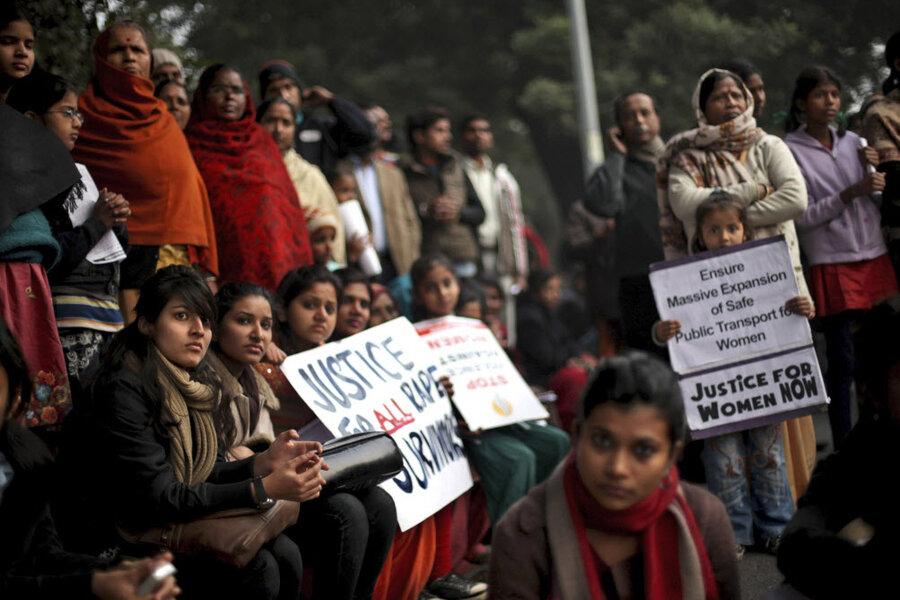India gang rape spurs national dialogue
Loading...
| New Delhi
The Indian government’s crackdown on the anti-rape protests that have continued for nearly two weeks in New Delhi has only aggravated public anger and concern about women’s safety.
The protests were sparked by the gang rape and brutal assault of a 23-year-old student on a bus in the elite South Delhi district on Dec. 16.
As the girl battles for her life in a Singapore hospital, Indians are debating how to make the country safer for women. Ten days after the incident, it dominates newspaper headlines and op-ed pages, pushing to the margins stories like the retirement of cricketer Sachin Tendulkar, the popular Indian sportsperson, highlighting just how much the case has affected people.
Sexual harassment is rampant in India, and the public has been largely apathetic to women’s plight, but many are hoping the attack could be a turning point in the way India treats women.
Calls for capital punishment, including the chemical castration of rapists, have died down, with various women’s groups decrying them. Given that in 94 percent of rape cases the rapist is known to the victim, Nilanjana S. Roy, writing in The Hindu newspaper she wonders if the protestors would be okay with death penalty if it were their father, uncle, neighbors, or even if it meant convicting Indian security forces in conflict zones.
The Monitor reported that India is considering a fast-track court process to expedite rape cases and step up punishment for sexual violence on the heels of the bus rape incident.
Beyond the law, what needs to happen, writes Shilpa Phadke, author of a book on women’s safety in Mumbai, has to do with how Indians use their streets: “We are safer when there are more women (and more men) on the streets. When shops are open, when restaurants are open, when there are hawkers and yes, even sex workers on the street, the street is a safer space for us all.”
The outrage that this case has spurred might finally bring about a cultural change in India, Stephanie Nolen of The Globe and Mail suggests in a report:
Women assaulted leaving bars or late at night or while wearing Western clothes have been chastised by police, judges and politicians for bringing their misfortune on themselves. This time, however, there is a current of defiance in the protests, noted Subhashini Ali of the All India Democratic Women’s Association. A young woman in central Delhi on Tuesday carried a sign saying, “Stop telling me how to dress, start telling your sons not to rape.”
But rape is still not seen as a men’s issue, Ms. Ali said. “I don’t think many people are asking that question yet [of how men are being brought up and how it shapes their attitude toward rape].”
“But that’s where we have to go.”
And that should start with using sexual education in schools as a means to counter systemic patriarchal attitudes, writes Ketaki Chowkhani in Kafila, a collaborative blog that I work with.
That need for an emphasis on social change rather than law enforcement was also highlighted by Praveen Swami in The Hindu newspaper. India could learn a lot from the United States, he writes, where the incidence of rapes have fallen:
“The decline in rape in the U.S. has mainly come about not because policing has become god-like in its deterrent value, but because of hard political and cultural battles to teach men that when a woman says no, she means no.”
Meanwhile, the crackdown on the protests in Delhi has drawn sharp reactions and much anger across the Internet. On Facebook, graphic designer Sangeeta Das narrated her experience of the protests on Dec. 23, republished on the Kafila blog:
“There were many volunteers distributing biscuits and water to every protestor. We were talking ... on how to tackle the violence on women and children starting from ourselves, our homes, and communities. We were simply talking ... when the police, hundreds of them ... charged at us from behind, without any warning.”
Meanwhile, the media have drawn the government’s ire. On Sunday, the same day one journalist was killed in Manipur when police opened fire on protestors, the government issued an advisory to news channels to show “maturity and responsibility” in their coverage of protests:
No programme should be carried in the cable service which is likely to encourage or incite violence or contains anything against maintenance of law and order or which promotes anti-national attitude.







